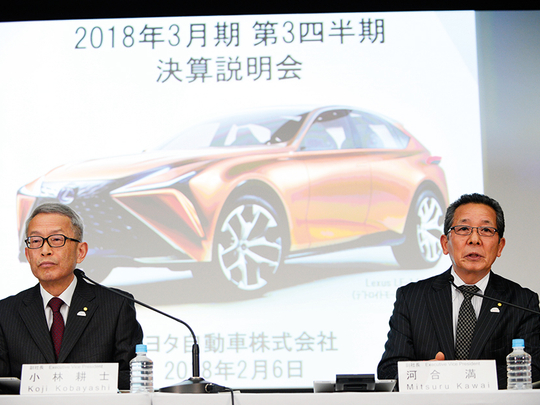
Tokyo: Toyota Motor Corp lifted its full-year profit forecast by 10 per cent on Tuesday after posting its best quarterly operating profit in two years, boosted by a weaker yen and strong sales at home.
Japan’s biggest automaker now expects operating profit to increase 10 per cent on the year to 2.2 trillion yen ($20.23 billion; Dh73.56 billion), from 1.99 trillion yen a year earlier and marking an upgrade from its previous forecast of 2 trillion yen.
It expects net profit to come in at 2.4 trillion yen, up from a previous forecast for 1.95 trillion yen and on track for a record high.
For the third quarter, Toyota posted 673.6 billion yen in operating profit for October-December, a 54 per cent jump from a year earlier. The result exceeded a mean estimate of 527.22 billion yen taken from 11 analysts polled by Thomson Reuters, and was its highest since October-December 2015.
Operating profit in Japan more than doubled as vehicle sales rose at home, while the automaker posted lower sales in North America, its biggest market, where it is struggling with heavy discounting as it tries to produce and sell larger vehicles.
Toyota sold 2.63 million vehicles globally in October-December, up from 2.28 million a year prior. Sales in Japan rose 3 per cent, while sales North America fell to 735,000 from 745,000 units. Sales in Europe rose 1.7 per cent.
Operating profit in North America tumbled 53.1 per cent.
Toyota has been struggling with rising marketing costs in the region amid steep discounting among automakers trying to sell more cars in the slowing US market.
Toyota has had a bumpy ride in the United States, its biggest market where it trails only General Motors Co and Ford Motor Co in terms of sales, as automakers continue to angle for higher market share as overall sales retreat from a record high hit in 2016.
Profitability in the US market is key for Toyota to help generate funds as it invests heavily in new technologies including self-driving functions, electric cars and new mobility services.
As US drivers continue to gravitate towards larger pick-up trucks and SUVs over sedans and hatchbacks, Toyota, best known for its Camry and Corolla sedans, has been scrambling to shift more production from cars to trucks.
Meanwhile, it has been selling its sedans at hefty discounts for much of 2017 to bolster demand for models like the Camry, while also raising incentives on its SUVs and trucks to remain competitive in the US market.
This has lifted overall marketing costs per vehicle by 10 per cent in 2017 from 2016, according to figures from Autodata.












